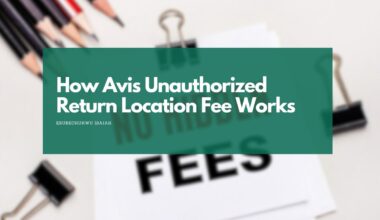As an Amazon Associate, I earn a small commission from qualifying purchases. Learn more about this.
When renting a car, most of us focus on the basics—model, price, and insurance options. However, knowing what to expect if the car suffers a scratch is just as important.
We’ve researched Budget Car Rental’s scratch policy so you don’t have to. Here’s everything you need to know to rent with confidence.
Understanding What Budget Car Rental Scratch Policy Entails
So, you’ve decided to go with Budget Car Rental for your next trip. Good choice.
Budget is known for its competitive pricing and wide range of vehicle options, but it’s not just about the upfront costs. It’s also about what could come later, like those unexpected scratches that can put a dent in your wallet.
Before you drive off into the sunset, let’s dive into Budget Car Rental’s scratch policy to make sure you’re completely in the know.
First things first, you should be aware that any form of damage to the rental car, including scratches, will generally be your responsibility unless you’ve opted for the rental company’s coverage options.
The cost associated with repairing a scratch can vary greatly depending on its size and location, and you could be charged not just for the repair but also for the “loss of use” of the vehicle during the repair period.
And just like this, there are also some scratches that may not incur any extra cost even when discovered.
So how does Budget determine what scratches are charged and others that are not?
Generally, this information is not on the Internet but after conversations with a handful of Budget and Avis employees at different locations, I was finally able to lay my hands on the company’s damage evaluator.
Let’s take a look at them in detail.
Reference: For every scratch considerd “fair wear and tear,” drivers are not charged.
Dents
- Fair Wear and Tear: Dents smaller than 25 mm in diameter, where the paint is unbroken.
- Not Accepted: Hail damage, dents on certain areas like bonnets and roofs, and any dent affecting the paintwork.
Stone Chips
- Fair Wear and Tear: Isolated stone chips up to 2 mm in diameter on any panel.
- Not Accepted: More than five stone chips in a localized area.
Scratches
- Fair Wear and Tear: Light scratches under 25 mm in length and 1 mm in width that don’t penetrate the paint and can be polished out.
- Not Accepted: Any scratch exposing the metal, plastic, or undercoat.
Bumpers
- Fair Wear and Tear: Minor scratches or scuffs under the front bumper that are not visible from 2 meters away, and isolated stone chips up to 2 mm.
- Not Accepted: Broken paint, multiple scratches, or dents larger than 25 mm.
Wheels and Tyres
- Fair Wear and Tear: Light scratches and scuffs up to 20 mm on wheels.
- Not Accepted: Damage to wheel trims, mismatched or non-original rims, and any form of tire damage making it unroadworthy.
Windscreen and Windows
- Not Accepted: Any form of scratches, chipping, cracks, or holes as they affect the vehicle’s roadworthiness.
Interior Condition
- Fair Wear and Tear: Light marks that can be vacuumed or cleaned.
- Not Accepted: Permanent damage, tears, cuts, or pet hair.
Keys and Accessories
- Fair Wear and Tear: Minor cosmetic damage that doesn’t affect functionality.
- Not Accepted: Loss or damage to keys or remotes, damage caused by incorrect accessory fitting.
What’s the charge for Rental Car Damges on Budget?
Damage Excess Charge
The first term you need to be aware of is the “Damage Excess Charge.” This is the amount you’ll be responsible for if the rental car is damaged while in your care.
The charge varies depending on the type of car, your age, and even the rental location. Make sure you’re aware of this figure when you sign your rental agreement.
Minor Damages
For smaller issues like scratches that fall outside of the “Fair Wear and Tear” guidelines, you could be looking at fees that range from $50 to a couple of hundred dollars.
However, these are not set in stone and may vary depending on the rental location and severity of the damage.
Major Damages
If you’re in a situation where the damage is extensive, for example, a deep scratch that exposes the metal or a significant dent, brace yourself.
The costs could escalate into the thousands, especially if the car needs to be taken to a body shop for repair.
Insurance Coverage
It’s worth mentioning that if you’ve opted for any of Budget’s insurance packages or your personal auto insurance covers rental cars, these costs could be significantly reduced or even completely covered.
However, be sure to read the fine print and understand the limitations and conditions that apply.
Administrative Fees
For most fines you’ll get driving a rental car, the administrative fees are usually added onto the damage costs for processing the claim, and while they may seem minimal, they can add up.
For rental car damages, this is not an exception.
Some fees start at $50 and can go up, depending on the complexity of the damage and the administrative work involved.
How to Avoid Being a Victim of Car Rental Scratch Policy
Being a victim of a car rental scratch can obviously be nerve-racking, so are there are some steps to avoid them?
Well, yes:
1. Conduct a Thorough Inspection
Before you even put the key in the ignition, do a comprehensive inspection of the vehicle.
Check for any existing dents, scratches, or other issues that could later be pinned on you. Make it a point to report these to the rental company immediately.
Many people even recommend taking timestamped photos or videos as proof. Trust us, it’s a 10-minute job that can save you a lot of trouble later on.
2. Understand Your Insurance Coverage
Insurance can be a lifesaver when it comes to scratches and dents, but not all insurance is created equal. If you’re relying on your own car insurance, read the policy to see what’s covered and what’s not.
If you’re taking Budget’s additional coverage options, make sure to understand their terms too. Sometimes these policies cover scratch repairs, but under specific conditions.
3. Drive Carefully
This might sound obvious, but cautious driving goes a long way in avoiding scratches and dents.
Avoid tight parking spots, keep a safe distance from other vehicles, and be extra careful when navigating through narrow or busy areas. Remember, you’re driving an unfamiliar vehicle, and it’s better to be safe than sorry.
4. Return the Car During Business Hours
Try to return the car when the rental office is open. This way, an agent can inspect the vehicle while you’re present, and any discrepancies can be resolved on the spot. If you can’t avoid an after-hours return, the timestamped photos you took earlier will be crucial evidence in case of disputes.
5. Keep a Record
Save all the documents, emails, and receipts related to your rental. This includes your rental agreement, your insurance coverage, and any correspondence with the company.
These could come in handy if you find yourself in a situation where you need to dispute a scratch or dent charge.
Conclusion
Understanding Budget Car Rental’s scratch policy and the precautions you can take to protect yourself are crucial to ensuring a smooth rental experience.
By conducting a thorough inspection, knowing your insurance options, and documenting every detail, you put yourself in a strong position to avoid unexpected fees.
Drive with peace of mind, knowing you’ve done your homework.







